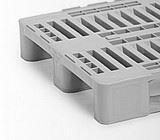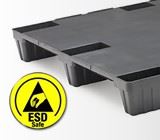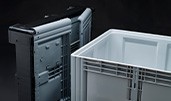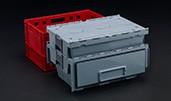But what are the most common failures that occur most often when consolidating goods on pallets? In the following lines, the Naeco team cites the most common mistakes in the process.
Risk factors when palletizing and packing loads
Giving a single misstep when palletizing or packing goods would result in serious damage to the product, facilities, or even personal damage. Irreparable damage which may involve the total loss of the load. Below we show you some measures that can be taken to ensure the stability of the goods and avoid any damage:
- Choosing the correct pallet size is very important when palletizing the goods. If the products or boxes exceed the dimensions of the pallet, the load is not distributed evenly on the pallet, which can destabilize the load. Therefore, it is necessary to consider the exact measurements of the packaging so that the goods fit perfectly on the pallet. In this way we avoid dangerous cracks, hollows, and imbalances. Likewise, the measures and the weight of plastic pallets, must conform according to the characteristics, dimensions, types of cargo and the specific needs of each sector. If we take this information into account, we will obtain a correct palletization of the packaged product. In relation to the size of the pallets, in Europe there are two standard dimensions, one of 1200x800mm, used for commercial distribution and the other of 1200x1000mm, more common in industrial applications. However, to this kind of standardized pallets we must add other more personalized parameters intended for concrete uses.
- Adequately report the conditions of the pallet and / or merchandise. Knowing the external conditions supported by the pallet, for example, in humid environments, is another essential factor throughout palletizing. With this information we will be able to add to the pallet the elements necessary to protect the goods. The ideal is to mark pallets and boxes with adhesive stickers displaying symbols or texts warning about the need for specifictreatments and about their stacking resistance. It is also important that these labels are clearly visible on each side of the pallet to avoid possible errors.
- Consolidate the load. Using insufficient film or strapping to protect the goods once palletized is a very common mistake. Once the goods are in place, it is important to secure them with elements such as strapping or film to guarantee the stability of the load. It is important not to save on the amount of film needed to wrap, protect, and support the merchandise at the base of the pallet. This is to prevent the load from falling, breaking, or slipping during transfer or storage. Greater fixation and greater stability of the goods will be achieved if we have anti-slip elements if greater grip is required.
- Check that the merchandise is well nested. If the cargo does not fit properly on the pallet, it is very likely that the cargo will become unbalanced and end up damaged on the floor. Therefore, before transferring the goods, check that they are properly assembled, and that the unity of the load is guaranteed together with the pallet.
- Other retention elements. Rims in the outer perimeter of the pallet. Rims help holding both empty pallets stacked in a warehouse and those containing merchandise. These elements are used mainly during the transport of boxes.
- Rubber option on the transom and / or on the pads. Certain types of handling or types of goods make it necessary to have additional elements available to improve grip and facilitate handling. In the case of some Naeco plastic pallet models we have the option of rubber on the transom and / or pad and anti-slip strips on the transom. The ant slip caps on the desk improve grip and ensure the stability of the pallet and the goods during handling with the cart. Anti-slip cap tips on the shoe promote stability on roller tracks, metal platforms, etc. These types of add-ins are not necessary on all circuits, but where they are needed, they ensure the stability of the unit load. Finally, the anti-slip strips offer greater retention of the goods, when, for example, by themselves, the perimeter ridges are not sufficient.
Taking the necessary measures and choosing the right plastic pallet to ensure load stability, is essential if we are to avoid serious palletizing errors that endanger all the goods being transported before they reach their destination.
Would you like to know what type of pallet best suits the needs of your merchandise to ensure that it is in good condition throughout transport? Get in touch with us. We will help you to optimize and get the most out of your company's logistics.














